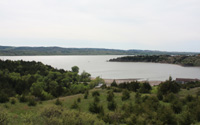NO POCAHONTAS HERE!
NO POCAHONTAS HERE!
By CHANTAL COOKE.
Pine Ridge Indian reservation in South Dakota is everything you wish an Indian reservation wasn’t.
There are no beautiful Pocahontas look-a-likes in moccasins and beaded clothes, no strong Indian chiefs dispensing wise words and encouraging us to live in tune with nature.
Instead, as you enter the reservation, the unspoilt landscape morphs into one covered by the detritus of human existence.
Old plastic bags flap in the wind, caught on the barbed wire fences, tatty mobile homes appear randomly plonked on the prairie grass – their surrounds covered in rusting cars and old tyres.
Pine Ridge, the second largest reservation in the US, is home to about 40,000 people. The median income is ,600 with over 85% unemployment. Infant mortality is 300% higher than the US national average, cervical cancer is 500% and tuberculosis 800% higher. It has the shortest life expectancy (45 years) of any community in the Western hemisphere outside of Haiti.
Pine Ridge is also the home of the Wounded Knee Memorial, reminding us all of the massacre that happened there in 1890 when 250 mainly unarmed Lakota Sioux were gunned down by the army.
This event marked the closing chapter of the tragic Indian Wars. The site and the people who died are commemorated by a small grave yard with a central stone memorial on the side of the hill. 43 of the massacred Sioux have their names carved into the pale grey marble. The remaining 207 are not commemorated by name – one has to assume that these were the less important women and children.
As I stare at the other grave markers, I wonder what Long Cat, an Indian women born here in 1904 and buried here in 1997 must have seen during her 90+ years.
A young Indian girl in a purple t-shirt and far too much foundation appears and tells me she is trying to get some money together to hold a party that night – can I help? I ask her if she lives here, she points to a group of mobile homes a couple of hundred metres away. Clearly she saw me and my obvious tourist look and walked across from her home in the hopes of prising a few dollars from my heaving foreigner’s purse. It’s not a great way to make a living.
And the same can be said for the family positioned in the car park at the bottom of the hill. One older woman sits creating small Tepee Dreamcatchers and her husband and sons accost anyone who stops, offering the craftwork for a piece. “Each one takes an hour to make” she tells me earnestly.
If Wounded Knee and the litter strewn reservation aren’t enough to depress you then the town of Pine Ridge on the South Dakota-Nebraska border will be. There’s not much to do or see – a large supermarket, a petrol station and a Pizza Hut, which sadly is the best (and almost the only) option for lunch. Stray dogs dodge the cars and pock-faced men knock on the window of the car offering me jewellery and Indian crafts.
Two miles south, past more junk yards and dumped rubbish you cross the border into Nebraska and the 10 metre frontage that makes up the tiny town of Whiteclay. Like everywhere else most of the rundown buildings are closed – with the exception of the liquor store. From here I watch a small stream of inebriated men weave their way out of the store and across the road – to where? I have no idea – there is nowhere.
There’s no way to justify the evil the white man bestowed on the red Indian – the way we took their land, killed their culture and way of life, and broke all the promises we ever made to them. And there is no way to describe just how sad and depressed these people look today – over 100 years after that fateful day in 1890.
For more information:
Friends of Pine Ridge Reservation
Oglala Sioux
South Dakota Tribal Relations
Wounded Knee Museum
About the Author:
Chantal Cooke is an award winning journalist and broadcaster.

